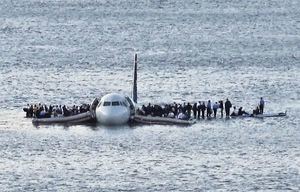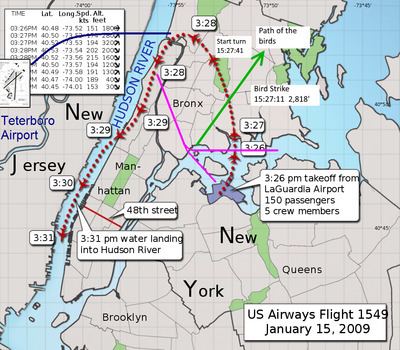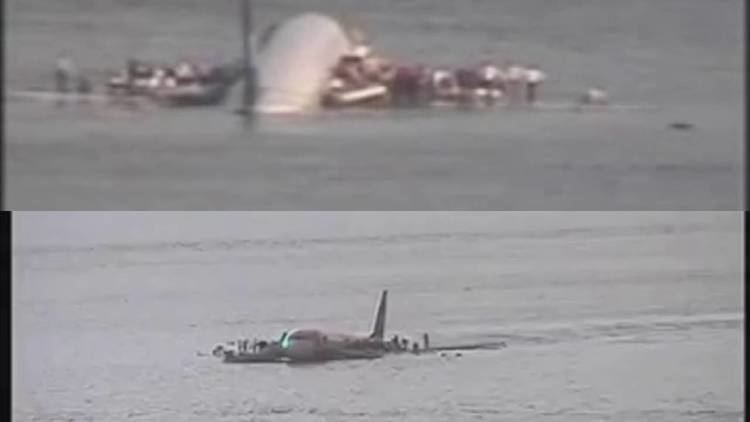Passengers 150 Survivors 155 (all) Number of deaths 0 Survivor 155 (all) | Fatalities 0 Date 15 January 2009 Passenger count 150 Crew count 5 | |
 | ||
Summary Controlled ditching after multiple large bird strikes Injuries (non-fatal) 100 (95 minor, 5 serious) Similar United Airlines Flight 232, Malaysia Airlines Flight 370, TransAsia Airways Flight 222, American Airlines Flight 191, Colgan Air Flight 3407 | ||
US Airways Flight 1549 was an Airbus A320-214 which, three minutes after takeoff from New York City's LaGuardia Airport on January 15, 2009, struck a flock of Canada geese just northeast of the George Washington Bridge and consequently lost all engine power. Unable to reach any airport, pilots Chesley Sullenberger and Jeffrey Skiles glided the plane to a ditching in the Hudson River off midtown Manhattan. All 155 people aboard were rescued by nearby boats and there were few serious injuries.
Contents
- Ntsb animation us airways flight 1549 the hudson river emergency landing
- Route aircraft crew and passengers
- Takeoff and bird strike
- Ditching and evacuation
- Rescue
- Aftermath
- Investigation
- Crew awards and honors
- Media and popular culture
- References
The incident came to be known as the "Miracle on the Hudson", and a National Transportation Safety Board member described it as "the most successful ditching in aviation history." The pilots and flight attendants received the Master's Medal of the Guild of Air Pilots and Air Navigators for a "heroic and unique aviation achievement".

Ntsb animation us airways flight 1549 the hudson river emergency landing
Route, aircraft, crew and passengers

On January 15, 2009, US Airways Flight 1549 with callsign 'CACTUS 1549' was scheduled to fly from New York City's LaGuardia Airport (LGA) to Charlotte Douglas (CLT), with direct onward service to Seattle–Tacoma International Airport in Washington State. The aircraft was an Airbus A320-214 powered by two GE Aviation/Snecma-designed CFM56-5B4/P turbofan engines.

The pilot in command was 57-year-old Chesley B. "Sully" Sullenberger, a former fighter pilot who had been an airline pilot since leaving the United States Air Force in 1980. At the time, he had logged 19,663 total flight hours, including 4,765 in an A320; he was also a glider pilot and expert on aviation safety. First officer Jeffrey B. Skiles, 49, had accrued 15,643 career flight hours, but this was his first Airbus A320 assignment since qualifying to fly it. There were 150 passengers and three flight attendants aboard.
Takeoff and bird strike

The flight was cleared for takeoff to the northeast from LaGuardia's Runway 4 at 3:24:56 pm Eastern Standard Time (20:24:56 UTC). With Skiles in control, the crew made its first report after becoming airborne at 3:25:51 as being at 700 feet (210 m) and climbing.
The weather at 2:51 p.m. was 10 miles visibility with broken clouds at 3,700 feet, wind 8 knots from 290°; an hour later it was few clouds at 4,200 feet, wind 9 knots from 310°. At 3:26:37 Sullenberger remarked to Skiles: "What a view of the Hudson today."
At 3:27:11 the plane struck a flock of Canada geese at an altitude of 2,818 feet (859 m) about 4.5 miles (7.2 km) north-northwest of LaGuardia. The pilots' view was filled with the large birds; passengers and crew later reported hearing "very loud bangs" and seeing flames from the engines, followed by silence and an odor of fuel.
Realizing that both engines had shut down, Sullenberger took control while Skiles worked the checklist for engine restart. The aircraft slowed but continued to climb for a further nineteen seconds, reaching about 3,060 feet (930 m) at an airspeed of about 185 knots (343 km/h; 213 mph), then began a glide descent, accelerating to 210 knots (390 km/h; 240 mph) at 3:28:10 as it descended through 1,650 feet (500 m).
At 3:27:33, Sullenberger radioed a Mayday call to New York Terminal Radar Approach Control (TRACON): "... this is Cactus 1539 [sic – correct call sign was Cactus 1549], hit birds. We've lost thrust on both engines. We're turning back towards LaGuardia". Air traffic controller Patrick Harten told LaGuardia's tower to hold all departures, and directed Sullenberger back to Runway 13. Sullenberger responded, "Unable".
Sullenberger asked if they could attempt to land in New Jersey, mentioning Teterboro Airport; controllers obtained permission for a landing on Teterboro's Runway 1. Sullenberger responded: "We can't do it ... We're gonna be in the Hudson". The aircraft passed less than 900 feet (270 m) above the George Washington Bridge. Sullenberger commanded over the cabin address system, "Brace for impact", and the flight attendants relayed the command to passengers.
Ditching and evacuation
About ninety seconds later, at 3:31 pm, the plane made an unpowered ditching, descending southwards at about 125 knots (140 mph; 230 km/h) into the middle of the North River section of the Hudson tidal estuary, at 40.7695°N 74.0046°W / 40.7695; -74.0046 roughly opposite West 50th Street (near the Intrepid Sea, Air & Space Museum) in Manhattan and Port Imperial in Weehawken, New Jersey. Flight attendants compared the ditching to a "hard landing" with "one impact, no bounce, then a gradual deceleration." The ebb tide then began to take the plane southward.
Sullenberger opened the cockpit door and ordered evacuation. The crew began evacuating the passengers through the four overwing window exits and into an inflatable slide/raft deployed from the front right passenger door (the front left slide failed to operate, so the manual inflation handle was pulled). A panicking passenger opened a rear door; a flight attendant tried but failed to reseal the door. Water was also entering a hole in the fuselage and through cargo doors that had come open, so as the water rose the attendant urged passengers to move forward by climbing over seats. One passenger was in a wheelchair. Finally, Sullenberger walked the cabin twice to confirm it was empty.
Some evacuees waited for rescue knee-deep in water on the partially submerged slides, some wearing life-vests. Others stood on the wings or, fearing an explosion, swam away from the plane. One passenger, after helping with the evacuation, found the wing so crowded that he jumped into the river and swam to a boat. The air and water temperatures were about 19 °F (−7 °C) and 41 °F (5 °C) respectively..
Rescue
Sullenberger had ditched near boats to facilitate rescue. NY Waterway ferries Thomas Jefferson (commanded by Captain Vince Lombardi) and then Governor Thomas H. Kean (commanded by Brittany Catanzaro) both arrived within minutes and began taking people aboard using a Jason's cradle. Sullenberger advised the ferry crews to rescue those on the wings first, as they were in more jeopardy than those on the slides, which detached to become life rafts. As the plane drifted, passengers on one slide, fearing that the boat would crush them, shouted for it to steer away. The last person was taken from the plane at 3:55 pm.
About 140 New York City firefighters responded to nearby docks, as did police, helicopters, and various vessels and divers. Other agencies provided medical help on the Weehawken side of the river, where most passengers were taken.
Aftermath
There were five serious injuries, including a deep laceration in flight attendant Doreen Welsh's leg. Seventy-eight people were treated, mostly for minor injuries and hypothermia, twenty-four passengers and two rescuers treated at hospitals, with two passengers kept overnight. One passenger now wears glasses because of jet fuel damaging his eyes. No pets were being carried on the flight.
Each passenger later received a letter of apology, $5,000 in compensation for lost baggage (and $5,000 more if they could demonstrate larger losses) and refund of the ticket price. In May 2009 they received any belongings that had been recovered. In addition, they reported offers of $10,000 each in return for agreeing not to sue US Airways.
Many passengers and rescuers later experienced post-traumatic stress symptoms such as sleeplessness, flashbacks, and panic attacks; some began an email support group. Patrick Harten, the controller who had worked the flight, said that "the hardest, most traumatic part of the entire event was when it was over", and that he was "gripped by raw moments of shock and grief".
To prevent similar incidents, officials captured and gassed 1,235 Canada geese at 17 locations across New York City in mid-2009 and coated 1,739 goose eggs with oil to smother the developing goslings.
Investigation
The partially submerged plane was moored to a pier near the World Financial Center in Lower Manhattan, roughly 4 miles (6 km) downstream from the ditching location. The left engine, detached by the ditching, was recovered from the riverbed. On January 17 the aircraft was barged to New Jersey.
The initial National Transportation Safety Board (NTSB) evaluation that the plane had lost thrust after a bird strike was confirmed by analysis of the cockpit voice and flight data recorders.
It was soon reported that a few days earlier the plane had experienced a less severe compressor stall, and its passengers had been told an emergency landing might be required, but the affected engine was restarted. The NTSB later reported that a faulty temperature sensor had been the cause, and that the engine had not been damaged in that incident.
On January 21, the NTSB found evidence of soft-body damage in the right engine along with organic debris including a feather. The left engine also evidenced soft body impact, with: "dents on both the spinner and inlet lip of the engine cowling. Five booster inlet guide vanes are fractured and eight outlet guide vanes are missing". Both engines, missing large portions of their housings, were sent to the manufacturer for examination. On January 31, the plane was moved to Kearny, New Jersey. The bird remains were later identified by DNA testing to be Canada geese, which typically weigh more than engines are designed to withstand ingesting.
Because the plane was assembled in France the European Aviation Safety Agency (the European counterpart of the FAA) and the Bureau d'Enquêtes et d'Analyses pour la Sécurité de l'Aviation Civile (the French counterpart of the NTSB) joined the investigation, with technical assistance from Airbus Industrie and GE Aviation/Snecma, respectively the manufacturers of the airframe and the engines.
The NTSB used simulators to test the possibility that the flight could have returned safely to LaGuardia or diverted to Teterboro; only eight of the fifteen runs succeeded, although all four attempts to reach the nearest LaGuardia runway 22 were successful. The NTSB report noted that these test conditions were unrealistic: "The immediate turn made by the pilots during the simulations did not reflect or account for real-world considerations ". One further simulation was conducted with the pilot delayed by 35 seconds: he crashed.
Sullenberger testified in hearings before the NTSB. He maintained that there had been no time to execute the maneuver needed to return the plane to any airport, which might have killed those onboard and more on the ground. The Board ultimately ruled that Sullenberger had made the correct decision in ditching the plane. The NTSB's reasoning was that the dual-engine failure checklist addresses power loss at altitude, when pilots have more time to deal with the situation, and that while simulations showed that the plane might just have made it back to LaGuardia, those scenarios required the pilot to make an instant decision without taking any time to assess the situation.
The NTSB concluded its investigation on May 4, 2010, and determined the probable cause to be "the ingestion of large birds into each engine, which resulted in an almost total loss of thrust in both engines." The final report credited the outcome to four factors: good decision-making and teamwork by the cockpit crew (including decisions to immediately turn on the APU and to ditch in the Hudson); the fact that the A320 is certified for extended overwater operation (and hence carried life vests and additional raft/slides) even though not required for that route; the performance of the flight crew during the evacuation; and the proximity of working vessels to the ditching site. Contributing factors were good visibility and a fast response from the ferry operators and emergency responders. The report also makes a range of recommendations to improve safety in such situations.
Author and pilot William Langewiesche asserted that insufficient credit was given to the A320's fly-by-wire design, by which the pilot uses a side-stick to communicate control inputs to a computer. The computer then imposes adjustments and limits of its own to keep the plane stable, which the pilot cannot override even in emergency. This design allowed the pilots of Flight 1549 to concentrate on engine restart and deciding the course, without having themselves to achieve the best glidepath by manually reducing the plane's rate of descent after engine loss. However, Sullenberger said that these computer-imposed limits also prevented him from achieving the optimum landing flare for the ditching, which would have softened the impact. The NTSB report also makes clear that full operation of these systems was contingent on the pilot's decision immediately to activate the APU.
In 2010, the damaged plane (excluding its engines) was acquired for the Carolinas Aviation Museum in Charlotte, North Carolina, which held a reception on June 11 to commemorate the arrival in Charlotte of the plane's body, with Sullenberger as keynote speaker and the passengers invited.
Crew awards and honors
The crew, especially Sullenberger, were praised, notably by New York City Mayor Michael Bloomberg and New York State Governor David Paterson, who said: "We had a Miracle on 34th Street. I believe now we have had a Miracle on the Hudson." U.S. President George W. Bush said he was "inspired by the skill and heroism of the flight crew," and praised the emergency responders and volunteers. President-elect Barack Obama said that everyone was proud of Sullenberger's "heroic and graceful job in landing the damaged aircraft,". He thanked the crew, whom he invited, along with those who had helped ensure the safety of everyone aboard, to his inauguration five days later.
A National Transportation Safety Board (NTSB) Board member called the incident "the most successful ditching in aviation history."
The Guild of Air Pilots and Air Navigators awarded the crew a Master's Medal on January 22, 2009; this is awarded only rarely, for outstanding aviation achievements at the discretion of the Master of the Guild. New York City Mayor Michael Bloomberg presented the crew with the Keys to the City, and Sullenberger with a replacement copy of a library book lost on the flight, Sidney Dekker's Just Culture: Balancing Safety and Accountability. Rescuers received Certificates of Honor.
The crew received a standing ovation at the Super Bowl XLIII on February 1, 2009, and Sullenberger threw out the first pitch at the 2009 Major League Baseball season for the San Francisco Giants. His Giants' jersey was inscribed with the name "Sully" and the number 155 – the count of people aboard the plane.
On July 28, passengers Dave Sanderson and Barry Leonard organized a thank you luncheon for emergency responders from Hudson County, New Jersey, on the shores of Palisades Medical Center in North Bergen, New Jersey, where 57 passengers had been brought following their rescue, a mile north of the landing site. Present were members from the U.S. Coast Guard, North Hudson Regional Fire and Rescue, NY Waterway Ferries, the American Red Cross, Weehawken Volunteer First Aid, the Weehawken Police Department, West New York E.M.S., North Bergen E.M.S., the Hudson County Office of Emergency Management, the New Jersey E.M.S. Task Force, the Guttenberg Police Department, McCabe Ambulance, the Harrison Police Department, and doctors and nurses who treated survivors for hypothermia and other injuries following the incident.
Sullenberger was named Grand Marshal for the 2010 Tournament of Roses Parade in Pasadena, California.
In August 2010, Jeppesen issued an approach plate titled "Hudson Miracle APCH," dedicated to the five crew of Flight 1549 and annotated "Presented with Pride and Gratitude from your friends at Jeppesen."
Sullenberger retired on March 3, 2010, after thirty years with US Airways and its predecessor. At the end of his final flight he was reunited with Skiles and a number of the passengers from Flight 1549.
Media and popular culture
The incident, within a heavily populated city during daylight at the start of evening rush hour, was unusual in leaving a real-time video and photographic record. Video was recorded by several closed-circuit television cameras. Various television reports and documentaries produced soon afterwards contained extensive video of the ditching and rescue, and recorded interviews with the aircrew, passengers, rescuers, and other key participants. These included:
The Discovery Channel (Canada) / National Geographic TV series Mayday (also called Air Crash Investigation or Air Emergency) dramatized the accident in an episode titled Hudson Splash Down. It was also recreated in a National Geographic Channel TV special titled "Miracle Landing on the Hudson," and in the UK for a Channel 5 special in 2011.
Garrison Keillor honored the entire flight crew by writing a song and performing it on his show, A Prairie Home Companion.
The ditching is referenced in the song "A Real Hero" by College and Electric Youth, best known from the 2011 movie Drive. The lyrics of the second verse describe the water landing and the survival of the passengers and crew, as well alluding to the freezing river.
Sullenberger is referenced in the 2011 romantic comedy Friends with Benefits. Throughout the film, Justin Timberlake's character suggests that modern airplanes practically fly themselves, and that Sullenberger's feat was less impressive than portrayed, but is met with incredulity and hostility. Mila Kunis's character is seen reading Sullenberger's English Wikipedia article.
Sullenberger's memoir, Highest Duty: My Search for What Really Matters was adapted into a feature film Sully: Miracle on the Hudson, directed by Clint Eastwood, with Tom Hanks as Sullenberger and Aaron Eckhart as co-pilot Jeff Skiles. It was released by Warner Bros. on September 9, 2016.
